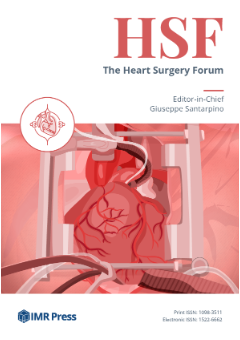Announcements
The Heart Surgery Forum (HSF) is published by IMR Press from Volume 28 Issue 9 (2025). Previous articles were published by another publisher under the CC-BY-NC licence, and they are hosted by IMR Press on imrpress.com as a courtesy and upon agreement.
Open Access
Article
The Nonselective ?-Blocker Carvedilol Suppresses Apoptosis in Human Cardiac Tissue: A Pilot Study
Heart Surg. Forum 2010, 13(4),
218–222;
https://doi.org/10.1532/HSF98.20091179
Published:
18 August 2010
Abstract
Background:Cardioplegia and reperfusion of the myocardium may be associated with cardiomyocyte apoptosis and subsequent myocardial injury. To establish a pharmacologic strategy for the prevention of these events, this study aimed to verify the reliability of our human cardiac model and to evaluate the antiapoptotic properties of the nonselective ?-blocker carvedilol during simulated cardioplegia and reperfusion ex vivo.Methods:Cardiac biopsies were retrieved before induction of cardiopulmonary bypass from the auricle of the right atrium of patients undergoing elective coronary artery bypass grafting. Biopsies were exposed to ex vivo conditions of varying periods of cardioplegia/reperfusion (30/10 minutes, 60/20 minutes, 120/40 minutes). Group I was the untreated control (n = 15), group II was the treated control (cardioplegia/reperfusion, n = 15), and group III was the experimental group (cardioplegia/reperfusion plus carvedilol, n = 15). Immunostaining for antibodies to activated caspase 3 and poly(ADP-ribose) polymerase 1 (PARP-1) cleavage was used to detect apoptosis.Results:The percentage of apoptotic cardiomyocytes was significantly lower (P< .05) in group I than in group II, revealing a time-dependent increase. In group III, carvedilol treatment suppressed apoptosis significantly (P< .05).Conclusion:Carvedilol significantly suppresses apoptosis in our ex vivo setting. This finding warrants further studies to evaluate the potential beneficial effects of carvedilol in suppressing ischemia/reperfusion injury in clinical settings.

